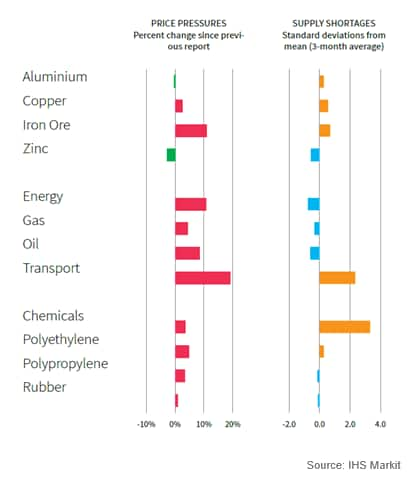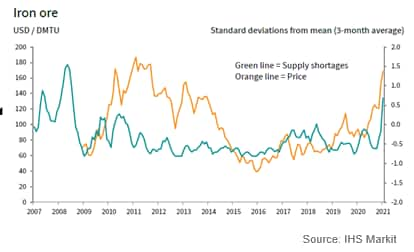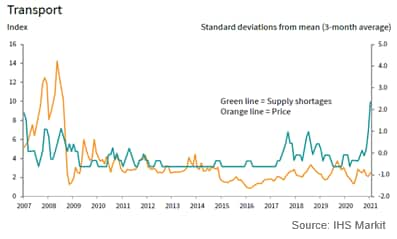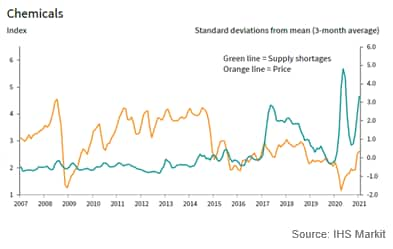Customer Logins
Obtain the data you need to make the most informed decisions by accessing our extensive portfolio of information, analytics, and expertise. Sign in to the product or service center of your choice.
Customer Logins
ECONOMICS COMMENTARY
Feb 15, 2021
Commodity prices rise amid intensifying supply pressures in January
- Iron ore prices soar as metal supply weakens
- Transport costs rise sharply amid container shortages
- Chemical prices increase, but at softer rate
The latest Price & Supply Monitor - a monthly report designed to track global commodity price pressures and supply shortages - saw higher prices across most of the major commodities in January. Inflation was mainly linked to a build-up of global supply chain issues due to the coronavirus disease 2019 (COVID-19) pandemic, including widespread input shortages and a lack of global freight containers
The IHS Markit Price & Supply Monitor is derived from IHS Markit Pricing & Purchasing data and the Purchasing Managers' Index™ (PMI) business surveys. PMI survey respondents are invited to itemise specific goods where supply shortages have developed. This information is transformed into indicators which show the development of supply pressures relative to long-run trends.

Across the monitored commodities, iron ore saw the sharpest uptick in price during January, followed by a strong rise in crude oil. Prices of chemical goods also rose, but at a far softer rate than seen at the end of 2020. Meanwhile, transport costs increased by over 19%, as global freight companies faced a dearth of container supply due to COVID-19 restrictions and rising export demand.
Iron ore prices soar to 112-month high as metal supply weakens
Metal prices remained elevated at the start of 2021, with iron ore and copper seeing further mark-ups as surveyed businesses reported a weakening in global supply. Iron ore registered the strongest uptick in price, rising 11% to its highest level since September 2011. At the same time, reports of supply shortages were the most frequent since mid-2008.

Copper also experienced both increasing supply pressures and a rise in price in January. The metal saw a more modest price increase of approximately 3%, but nevertheless reached its highest monthly average price for almost eight years. Aluminium and zinc, meanwhile, both recorded slight reductions in price after posting recent highs in December. Notably, zinc was the only monitored metal to not see a steep increase in supply pressures.
Transport costs rise sharply amid container shortages
Global energy markets saw further price inflation in January, as signalled by the IHS Markit Energy Prices Index which rose 11% since the end of last year. Crude oil contributed to the uptick with a 9% increase to $55/barrel, nearing the level seen in February 2020 before most major economies entered strict lockdowns.
Higher oil prices came at the same time as a sharp rise in freight costs in January. Sea freight companies reportedly struggled with low container supply as a result of disruption to shipping schedules from the COVID-19 pandemic. Consequently, transport costs climbed 19% over the month to the highest since last October.

Chemical prices increase, but at softer rate
Chemical prices were also influenced by supply pressures in January, with the number of firms reporting supply shortages of the commodity grouping rising to one of the highest levels on record. As a result, the IHS Markit Chemical Prices Index was up nearly 4% to its highest since October 2018. Moreover, the index has risen by 35% over the last two months, after a marked rise during December.

All three of the monitored chemical commodities saw upticks in price, led by polyethylene which increased by 5% to $2.25/pound. It was closely followed by polypropylene which recorded a 3% monthly increase. That said, these compared with rises of 39% and 18% in December respectively. Rubber prices edged up only fractionally in January, but nonetheless marked its highest price for nearly four years. Notably, mentions of weak rubber availability were the most frequent since July 2017.
David Owen, Economist, IHS Markit
Tel: +44 2070 646 237
david.owen@ihsmarkit.com
© 2021, IHS Markit Inc. All rights reserved. Reproduction in whole
or in part without permission is prohibited.
Purchasing Managers' Index™ (PMI™) data are compiled by IHS Markit for more than 40 economies worldwide. The monthly data are derived from surveys of senior executives at private sector companies, and are available only via subscription. The PMI dataset features a headline number, which indicates the overall health of an economy, and sub-indices, which provide insights into other key economic drivers such as GDP, inflation, exports, capacity utilization, employment and inventories. The PMI data are used by financial and corporate professionals to better understand where economies and markets are headed, and to uncover opportunities.
This article was published by S&P Global Market Intelligence and not by S&P Global Ratings, which is a separately managed division of S&P Global.
{"items" : [
{"name":"share","enabled":true,"desc":"<strong>Share</strong>","mobdesc":"Share","options":[ {"name":"facebook","url":"https://www.facebook.com/sharer.php?u=http%3a%2f%2fprod.azure.ihsmarkit.com%2fmarketintelligence%2fen%2fmi%2fresearch-analysis%2fcommodity-prices-rise-amid-intensifying-supply-pressures-in-january.html","enabled":true},{"name":"twitter","url":"https://twitter.com/intent/tweet?url=http%3a%2f%2fprod.azure.ihsmarkit.com%2fmarketintelligence%2fen%2fmi%2fresearch-analysis%2fcommodity-prices-rise-amid-intensifying-supply-pressures-in-january.html&text=Commodity+prices+rise+amid+intensifying+supply+pressures+in+January+%7c+S%26P+Global+","enabled":true},{"name":"linkedin","url":"https://www.linkedin.com/sharing/share-offsite/?url=http%3a%2f%2fprod.azure.ihsmarkit.com%2fmarketintelligence%2fen%2fmi%2fresearch-analysis%2fcommodity-prices-rise-amid-intensifying-supply-pressures-in-january.html","enabled":true},{"name":"email","url":"?subject=Commodity prices rise amid intensifying supply pressures in January | S&P Global &body=http%3a%2f%2fprod.azure.ihsmarkit.com%2fmarketintelligence%2fen%2fmi%2fresearch-analysis%2fcommodity-prices-rise-amid-intensifying-supply-pressures-in-january.html","enabled":true},{"name":"whatsapp","url":"https://api.whatsapp.com/send?text=Commodity+prices+rise+amid+intensifying+supply+pressures+in+January+%7c+S%26P+Global+ http%3a%2f%2fprod.azure.ihsmarkit.com%2fmarketintelligence%2fen%2fmi%2fresearch-analysis%2fcommodity-prices-rise-amid-intensifying-supply-pressures-in-january.html","enabled":true}]}, {"name":"rtt","enabled":true,"mobdesc":"Top"}
]}




